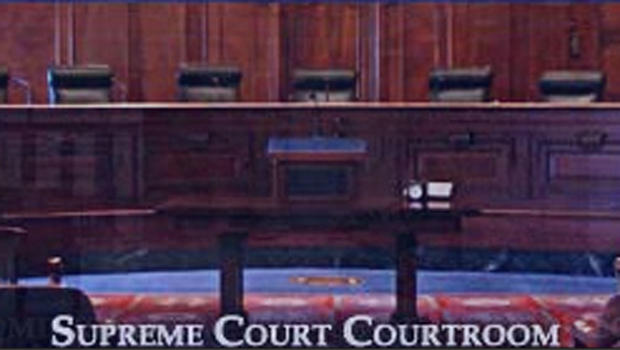Why do we still shackle kids in court?
This article originally appeared in The Crime Report,and is published in a cooperative venture with Crimesider.
When Skye Gosselin came to the Biddeford District Court on the coast of southern Maine to answer a disorderly conduct charge, a marshal put her in handcuffs and metal leg irons.
She was 12 years old.
Nearly five years later, the memory still haunts her.
"It makes you kind of feel like a really crazed criminal or an animal, and it sticks with you," Gosselin recalled recently in an interview with The Crime Report.![]()
The marshal determined she should be shackled at the juvenile hearing, where she received probation, because she had a warrant out for her arrest, Gosselin said.
According to Gosselin, she had missed the original juvenile court hearing scheduled for her case, which stemmed from threatening someone at school, because her mother misread the court summons.
As she awaited the hearing, shackled in handcuffs and clanging, heavy leg irons, Gosselin sat on a bench -- feeling the silent disapproval of other youths, court officials and the judge.
It was, she recalls, "terrifying."
Gosselin's experience wasn't unusual. At least 100,000 children are shackled nationwide annually, says the Washington-based, nonprofit Campaign Against Indiscriminate Juvenile Shackling, in a practice that has drawn mounting opposition from juvenile defense attorneys, mental health experts and others.
At least 29 states, including Maine, permit shackling of juveniles, says David Shapiro, an attorney who serves as the campaign's manager.
Defenders of the practice -- some judges, prosecutors and law enforcement officers -- say it's needed to maintain courtroom safety and deter escapes.
But the momentum against routine shackling has been growing, an investigation by The Crime Report shows.
As of May, 21 states and the District of Columbia had decided to limit shackling through legislation, administrative orders or court rulings -- typically requiring that prosecutors or court officials demonstrate a flight risk or danger to others in the courtroom before resorting to the practice.
Since the campaign began in August 2014, Alaska, Nebraska, Indiana, Utah, Nevada and the District of Columbia have decided to end routine shackling of youths, Shapiro said.
ABA Joins Campaign
The campaign received a boost in February, when the American Bar Association (ABA) adopted a resolution calling for a ban on blanket shackling of youth.
"Shackling of children in the courtroom without compelling justification is an inherently stigmatizing and traumatic practice that compromises the presumption of innocence," the ABA resolution said.
"Wholesale reliance on shackles in the juvenile court without an individualized determination that they are actually necessary is contrary to law, undermines the purpose of the juvenile court, and is inimical to the interests of children and youth in conflict with the law."
Critics interviewed by The Crime Report say routine shackling -- which can include handcuffs, belly chains and leg irons (weighing up to 25 pounds of metal, the anti-shackling campaign says) -- prejudices a judge by giving the appearance a child is guilty.
And many of the children shackled at hearings or trials have not been found guilty of anything yet.
Often, the shackled children are transported from juvenile detention centers after being held briefly. But in some cases, like Gosselin's, they are not.
Opponents point to extensive research showing that shackling youths who pose neither flight nor safety risks traumatizes them. Many of the children already have endured more than their share of trauma in their lives, as victims of, or witnesses to, violence or abuse.
Researchers, noting that adolescence is a critical stage of development, say shackling can cause long-term psychological damage, as well as making youth less likely to trust the court system and more likely to re-offend and even end up in the adult criminal justice system.
"In addition to being harmful to the child, the re-experiencing of the trauma may cause behavioral problems, both in the courtroom and later," Miami pediatrician Dr. Gwen Wurm said in a January 2015 affidavit. "The effort to control the child through shackling may lead to far more problematic behaviors."
That could be in part because being shackled makes it harder for children to communicate with their defense attorneys and to pay attention to and heed the judge's directions, Shapiro and others say.
'Treat Them Like Kids'
"I think kids need to be treated like kids, and that's the whole point of the juvenile justice system - rehabilitation," said George Dungan, a deputy public defender in Lancaster County, Neb., which includes the state capital, Lincoln, in an interview with The Crime Report.
"Indiscriminate shackling of these kids does a disservice to them in the long run mentally and judicially," he said.
Dungan said he has seen a teenage girl sentenced to detention for running away from home who cried in court but could not reach her eyes with a tissue because of shackles; and another mentally ill teen who tripped and fell in the courtroom while shackled.
A ban on blanket shackling in Nebraska takes effect in September.
Most of those who end up shackled appear in court for minor offenses such as shoplifting, skipping school or schoolyard scuffles.
In Baltimore, Christine Burke, supervising attorney for the juvenile division of the public defender's office, said kids as young as seven and eight have been shackled in the city's juvenile court.
"It's shocking to see a child brought out that way," Burke said. "We find it very degrading to the child, to their family. It really demonizes them. The juvenile court is supposed to be rehabilitative, not degrading."
Public defenders in the city can request the shackles be removed, but the judge denies the request about half the time, Burke said.
In addition to the ABA, other organizations that have expressed opposition to blanket shackling in recent years include the National Juvenile Defender Center, the American Academy of Child and Adolescent Psychiatry, the American Orthopsychiatric Association, the Child Welfare League of America, theNational Center for Mental Health & Juvenile Justice, the National Prevention Science Coalition to Improve Lives and the National Association of Counsel for Children.
Shapiro said he knows of no instances where the limitations on shackling of juveniles have endangered a courtroom or increased flight risk.
That squares with findings by the ABA, which cited a ban on indiscriminate shackling in Florida, and with anecdotal evidence from places like Utah and Nebraska that have tried pilot programs restricting juvenile shackling.
In its resolution, the ABA said: "The most common argument in favor of indiscriminate shackling focuses on courtroom safety and order. Shackles are not necessary, however, to maintain either safety or order, both of which can be achieved with less restrictive means."
These include increasing security personnel or locking courtroom doors to deter flight, the ABA said.
So why does blanket juvenile shackling persist in most of the country?
Shapiro blames a juvenile justice system that is still shackled in its own way to a punitive approach, and stakeholders who resist changing the status quo.
"The inertia of inaction is quite powerful," Shapiro said.
The National Council of Juvenile and Family Court Judges has yet to weigh in on blanket shackling of youths, but is expected to do in a resolution next month, said Shawn Marsh, chief program officer for juvenile law at the organization, based in Reno, Nev.
A draft resolution, to be presented to the council's board of directors, urges shackling not be used unless a "cogent rationale" for it is presented to a judge, and the judge would make the final decision, Marsh said.
As it stands, he said, in most jurisdictions, judges defer to security personnel: sheriffs, bailiffs and other law enforcement authorities.
"It's interesting some judges are resistant to push back against law enforcement," Marsh said. "Some judges just don't want to cross that bridge with the bailiffs and police. There's some tension there.... But our position is it's the judge's decision."
The federal government has no official policy on juvenile shackling, though federal marshals played a role in developing the Washington, D.C. ban on blanket shackling, which was the focus of a panel at a Coalition for Juvenile Justice conference last week in the nation's capital.
Practice Spread in the 1990s
Nobody seems to know precisely when routine shackling of youths began, though it appears to have spread during the get-tough-on-crime era of the 1990s.
The Supreme Court of Illinois became the first to address blanket shackling in a 1977 ruling in which the court found the use of restraints in court "infringed upon the rights of any defendant to communicate with counsel whether or not a jury was present," according to a 2012 study.
In that study, Children in Chains: Indiscriminate Shackling of Juveniles, Kim M. McLaurin, an associate clinical professor of law at Suffolk University Law School in Boston, argued that routine shackling of youths is unconstitutional and should be banned.
"Indiscriminate shackling sends the clear message that the juvenile justice system views adolescents as criminals, as people from whom society must be protected ... and as individuals presumed guilty at the very first appearance. This message and practice is not only harmful, but also unconstitutional," McLaurin wrote in the 26-page study in the Washington University (St. Louis) Journal of Law & Policy.
Ironically, adults in some ways receive more due process rights in court than children.
In 2005, the U.S. Supreme Court ruled 7-2 in Deck v. Missouri that it's unconstitutional to allow use of visible shackles during the sentencing phase of an adult defendant's trial unless doing so is "justified by an essential state interest" such as courtroom security.
The Court has not ruled on blanket juvenile shackling.
Other criticisms of the practice abound.
Noting that the overwhelming majority of youths involved in the juvenile justice system have brown or black skin, some critics portray shackling as a barbaric practice that recalls the nation's shameful history of slavery.
"In Baltimore City, 98 percent of our clients are black, and seeing kids in chains certainly evokes slavery," Burke said.
Shapiro shared those sentiments:
"Juvenile justice systems are already disproportionately impacting racial minorities," he said. "and in a county with a history of slavery, where a lot of the kids that we see in facilities and these hearings are black and brown, it's hard not to think of that history when you see young people in chains."
Skye Gosselin, the Waterboro, Me., girl shacked as a 12-year-old, has added her voice to the crusade to end routine juvenile shackling.
Gosselin, who is white, testified before a committee of the Maine legislature in April on a measure that would end routine shackling in the state.
Her experience in the Biddeford court was not the last time she found herself in chains. She was later shackled at age 14 after violating probation, stemming from a charge of fighting, by skipping school.
With help from a grandmother and counselors, Gosselin is faring much better these days. She is getting A's and B's in school, working two jobs, and preparing for college.
In the process, she has also found a voice to speak for others who have been through similar traumatic experiences.
In a May 2 op-ed for the Kennebec Journal and Morning Sentinel, she wrote that the physical pain wasn't the worst part:
"What I still think about today, nearly five years later, is the humiliation and shame I felt being in public view, weighed down by loud, metal shackles.... The dehumanizing experience shaped not only how others saw me, but how I saw myself for many years.
"The feeling of helplessness was one of the worst parts," she continued. "Being in those cuffs made me want to go crazy and just rip them off and tell everyone that I didn't need them because I'm a good person, but I couldn't. I felt as though everyone was seeing me as a criminal, and that I would be nothing to them but a lifelong offender."
This article originally appeared in The Crime Report.




